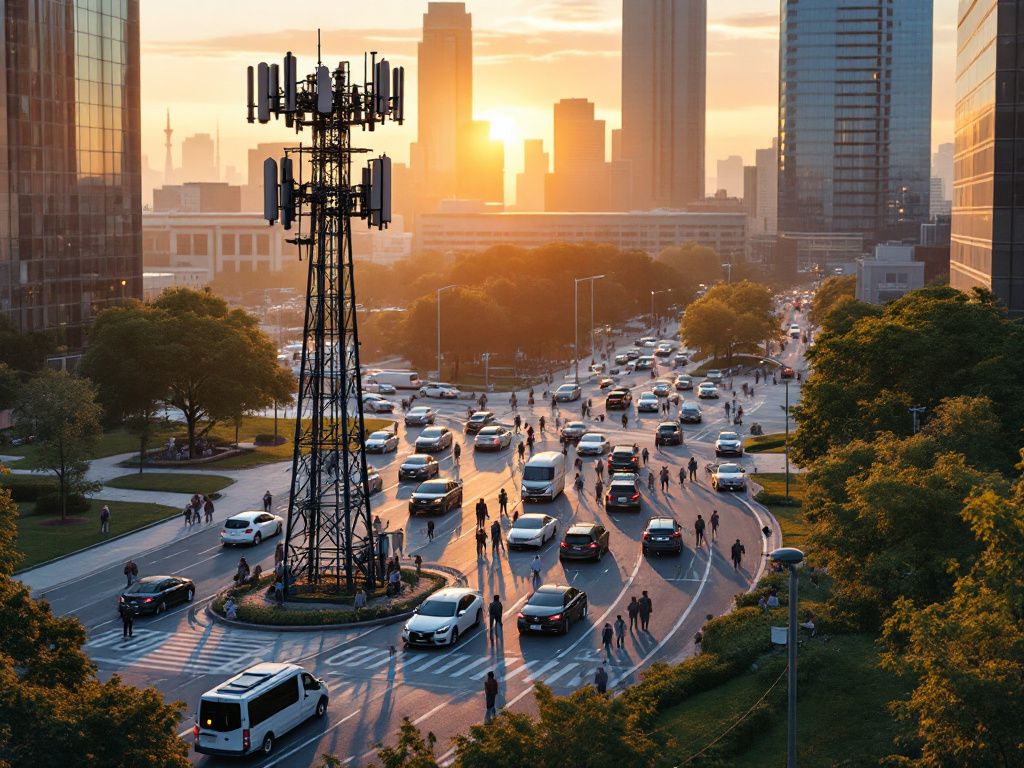5G technology represents a revolutionary leap in wireless communications, promising unprecedented speeds, ultra-low latency, and massive network capacity. This next-generation technology is transforming industries from healthcare to transportation, enabling new applications in IoT, augmented reality, and smart cities. Understanding 5G’s potential and impact is crucial as it reshapes our digital landscape and economic future.
Good to know
5G networks can deliver speeds up to 100 times faster than 4G, with latency reduced to as low as 1 millisecond, enabling real-time applications like remote surgery and autonomous vehicle control that were previously impossible with older wireless technologies.
Exploring the foundational technology behind 5G networks
The revolutionary leap from 4G to 5G represents one of the most significant technological advancements in wireless communications, fundamentally reshaping how data travels through the air. This transformation is built upon several groundbreaking innovations that work in harmony to deliver unprecedented performance capabilities.
The Foundation: 5G New Radio Standard
At the heart of 5G technology lies the global unified standard known as 5G NR (New Radio), developed by the 3rd Generation Partnership Project (3GPP). This standard represents a complete reimagining of wireless communication protocols, moving beyond the limitations of previous generations. Unlike 4G LTE, which operates primarily in lower frequency bands up to 6 GHz, 5G NR enables operation across a much broader spectrum range, including millimeter wave frequencies between 30 GHz and 300 GHz. This expanded frequency range provides dramatically more bandwidth, allowing for data transmission speeds that can reach up to 20 Gbps in optimal conditions.
Advanced Antenna Technologies
Massive MIMO Revolution
One of the most transformative technologies enabling 5G’s superior performance is massive MIMO (Multiple Input, Multiple Output). This technology employs arrays of hundreds of antennas at base stations, compared to the dozen or so antennas used in 4G systems. Companies like Ericsson and Nokia have pioneered massive MIMO implementations that can simultaneously serve multiple users with focused signal beams, dramatically increasing network capacity and spectral efficiency. This technology allows a single base station to handle up to 100 times more traffic than its 4G predecessors.
Precision Through Beamforming
Beamforming represents another crucial advancement, enabling 5G networks to direct radio signals with laser-like precision toward specific devices rather than broadcasting in all directions. This targeted approach reduces interference, improves signal quality, and enhances overall network efficiency. The combination of beamforming with massive MIMO creates a highly sophisticated wireless system capable of delivering consistent high-speed connectivity even in dense urban environments where thousands of devices compete for bandwidth simultaneously.

Understanding the far-reaching impact of 5G on mobile and IoT devices
The revolutionary capabilities of 5G technology are fundamentally transforming the landscape of mobile and IoT devices, delivering unprecedented performance improvements that extend far beyond simple speed enhancements. With ultra-low latency communications reaching as low as 1 millisecond and massive network capacity supporting up to 1 million devices per square kilometer, 5G creates an ecosystem where real-time interactions become seamless and ubiquitous connectivity becomes reality.
Enhanced Mobile Device Performance and IoT Integration
5G technology dramatically enhances mobile device capabilities through its superior bandwidth allocation and reduced latency. Modern smartphones equipped with 5G modems can achieve download speeds exceeding 10 Gbps in optimal conditions, enabling instant streaming of 4K content and seamless cloud-based applications. The low latency communications ensure that mobile gaming, video conferencing, and augmented reality applications respond instantaneously to user inputs, creating more immersive and responsive experiences.
For IoT devices, 5G’s massive machine-type communications (mMTC) capability represents a paradigm shift. Industrial sensors, smart city infrastructure, and connected vehicles can now operate with real-time data transmission, enabling sophisticated automation and monitoring systems. The enhanced reliability of 5G networks, with availability rates exceeding 99.999%, ensures critical IoT applications maintain constant connectivity.
Revolutionary Applications Across Key Industries
Healthcare Transformation
In healthcare, 5G enables remote surgery through haptic feedback systems, where surgeons can perform operations from thousands of miles away with sub-millisecond response times. Wearable medical devices continuously monitor patient vital signs, transmitting data in real-time to healthcare providers. Ambulances equipped with 5G technology can stream live patient data to hospitals, allowing emergency room teams to prepare treatment protocols before patient arrival.
Transportation Revolution
The transportation sector benefits significantly from 5G’s ultra-reliable low-latency communications (uRLLC). Autonomous vehicles rely on 5G networks to communicate with traffic infrastructure, other vehicles, and cloud-based navigation systems. Vehicle-to-everything (V2X) communication enables real-time traffic optimization, accident prevention, and coordinated autonomous driving systems across urban environments.
Entertainment Industry Evolution
Entertainment applications leverage 5G’s enhanced mobile broadband (eMBB) capabilities to deliver immersive experiences. Virtual and augmented reality applications benefit from the high-speed, low-latency connections, enabling real-time multiplayer gaming and interactive entertainment experiences that were previously impossible on mobile networks.

Decoding the economic benefits and challenges of deploying 5G
The transition to 5G networks presents a complex economic landscape where substantial benefits intersect with significant implementation challenges. As telecommunications providers and governments navigate this technological shift, understanding the financial implications becomes crucial for strategic planning and resource allocation.
Economic Benefits Driving 5G Investment
5G deployment promises substantial economic returns through enhanced productivity and innovative applications. The technology’s ultra-low latency and massive capacity enable new revenue streams in augmented reality, smart cities, and industrial automation. These capabilities support up to 1 million devices per square kilometer, creating opportunities for businesses to develop data-intensive applications that were previously impossible with 4G infrastructure.
Increased mobile broadband speeds reaching multiple gigabits per second facilitate real-time collaboration and efficient data processing, directly impacting business productivity. Industries leveraging 5G technology report improved operational efficiency through predictive maintenance, real-time logistics management, and automated manufacturing processes. The economic multiplier effect extends beyond telecommunications, stimulating growth in sectors ranging from healthcare to transportation.
Infrastructure Investment and Deployment Challenges
The capital requirements for 5G deployment present significant financial hurdles for telecommunications providers. Major carriers like Verizon and AT&T have invested billions in spectrum acquisition and infrastructure upgrades, with ongoing costs for dense small cell networks and advanced antenna systems. The deployment of millimeter wave frequencies requires substantially more base stations compared to 4G networks, increasing both initial investment and operational expenses.
Spectrum Allocation and Regulatory Framework
The Federal Communications Commission (FCC) plays a critical role in spectrum allocation, conducting auctions that generate substantial revenue while ensuring efficient frequency distribution. Spectrum costs represent a major portion of deployment expenses, with carriers competing for prime frequency bands that balance coverage and capacity requirements. Regulatory policies influence deployment timelines and investment strategies across the telecommunications industry.
Security Considerations and Risk Management
5G security challenges introduce additional economic considerations, requiring enhanced authentication systems and comprehensive risk management protocols. While 5G represents the most secure commercial mobile generation, the expanded attack surface and increased connectivity demand robust cybersecurity investments. These security requirements add complexity to deployment costs but remain essential for maintaining network integrity and user trust.

5G milestones: Progress and competitive landscape in different regions
The global 5G rollout has progressed at varying speeds across different regions, creating a complex competitive landscape shaped by technological capabilities, regulatory frameworks, and national strategic priorities. As of May 2025, distinct patterns have emerged in how different markets approach 5G expansion.
Regional Progress and Market Dynamics
Asia-Pacific continues to lead in 5G deployment metrics, with South Korea and China achieving extensive coverage in urban areas. The United States has focused on mid-band spectrum deployment following the C-band auction, while European markets have pursued a more coordinated approach through the European Union’s 5G Action Plan. Regional progress varies significantly based on spectrum availability, regulatory support, and investment capacity.
The competitive landscape has intensified among major infrastructure providers. Nokia has strengthened its position in North American markets through strategic partnerships with major carriers, while Ericsson maintains significant market share across European and Latin American regions. Samsung has emerged as a formidable competitor, particularly in the United States market, leveraging its expertise in both network equipment and consumer devices.
National Policies and Industry Partnerships
Government policies have significantly influenced 5G expansion trajectories. The United States has implemented security-focused policies affecting vendor selection, while European nations have adopted more nuanced approaches balancing security concerns with market competition. China’s domestic policies have accelerated internal deployment while creating challenges for international expansion.
The telecom industry anticipates transformative partnerships emerging in 2025 and beyond. Cross-industry collaborations between traditional network providers and technology companies are reshaping competitive dynamics. Edge computing integration and private network deployments represent key growth areas where established players and new entrants compete for market position.

What to remember about 5G technology
5G technology stands as a transformative force that will continue to reshape industries and societies worldwide. As deployment accelerates across regions, we can expect new innovations in autonomous vehicles, remote healthcare, and immersive entertainment experiences. The ongoing competition between major players and evolving regulatory frameworks will determine the pace of adoption. Future developments may include integration with satellite networks, enhanced security protocols, and the eventual transition toward 6G research, promising even more revolutionary capabilities in the years ahead.